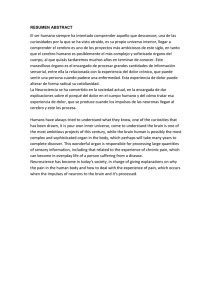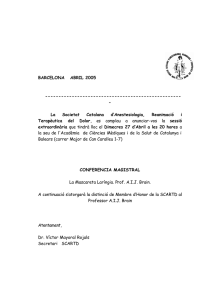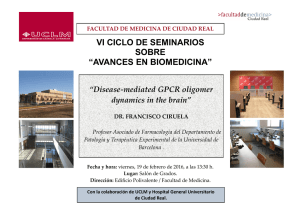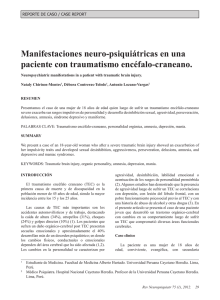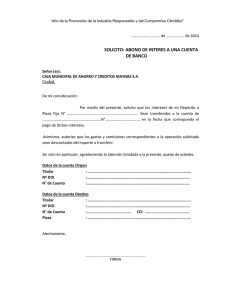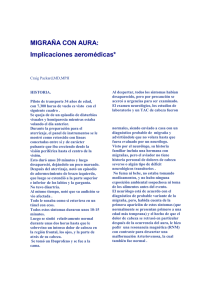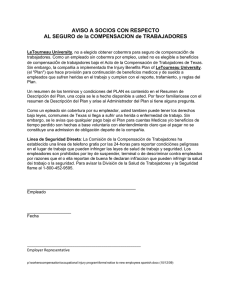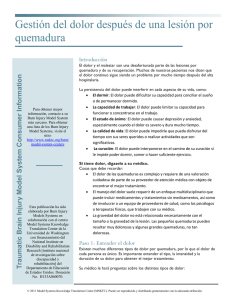Cefalea postraumática: advertencias clínicas
Anuncio
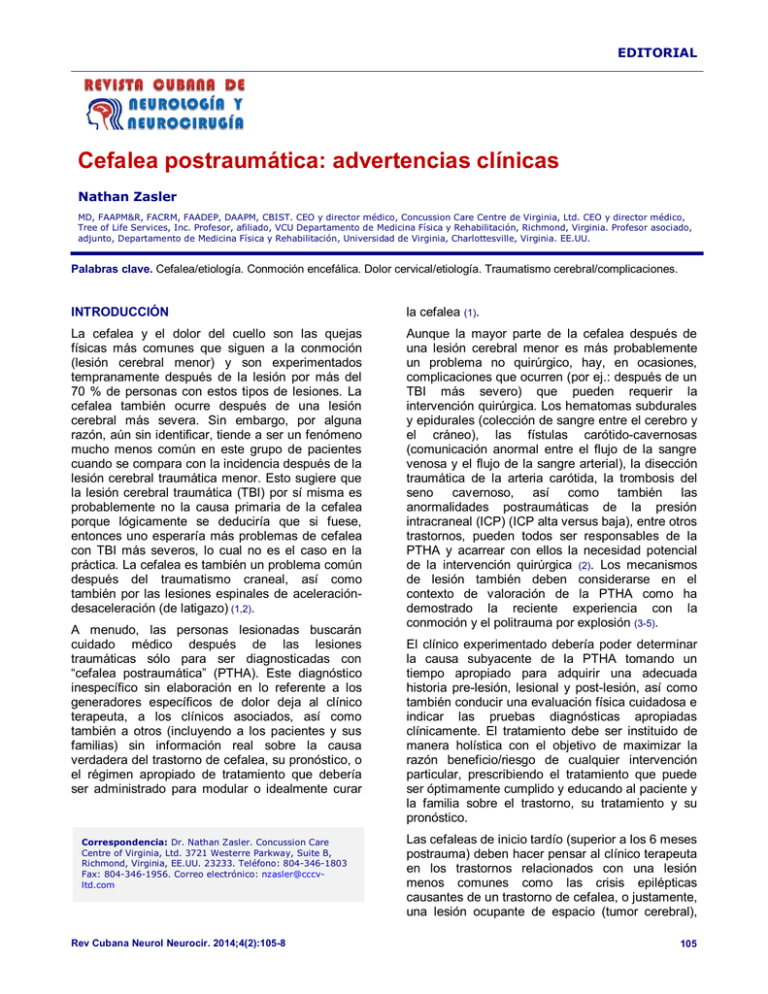
EDITORIAL Cefalea postraumática: advertencias clínicas Nathan Zasler MD, FAAPM&R, FACRM, FAADEP, DAAPM, CBIST. CEO y director médico, Concussion Care Centre de Virginia, Ltd. CEO y director médico, Tree of Life Services, Inc. Profesor, afiliado, VCU Departamento de Medicina Física y Rehabilitación, Richmond, Virginia. Profesor asociado, adjunto, Departamento de Medicina Física y Rehabilitación, Universidad de Virginia, Charlottesville, Virginia. EE.UU. Palabras clave. Cefalea/etiología. Conmoción encefálica. Dolor cervical/etiología. Traumatismo cerebral/complicaciones. INTRODUCCIÓN la cefalea (1). La cefalea y el dolor del cuello son las quejas físicas más comunes que siguen a la conmoción (lesión cerebral menor) y son experimentados tempranamente después de la lesión por más del 70 % de personas con estos tipos de lesiones. La cefalea también ocurre después de una lesión cerebral más severa. Sin embargo, por alguna razón, aún sin identificar, tiende a ser un fenómeno mucho menos común en este grupo de pacientes cuando se compara con la incidencia después de la lesión cerebral traumática menor. Esto sugiere que la lesión cerebral traumática (TBI) por sí misma es probablemente no la causa primaria de la cefalea porque lógicamente se deduciría que si fuese, entonces uno esperaría más problemas de cefalea con TBI más severos, lo cual no es el caso en la práctica. La cefalea es también un problema común después del traumatismo craneal, así como también por las lesiones espinales de aceleracióndesaceleración (de latigazo) (1,2). Aunque la mayor parte de la cefalea después de una lesión cerebral menor es más probablemente un problema no quirúrgico, hay, en ocasiones, complicaciones que ocurren (por ej.: después de un TBI más severo) que pueden requerir la intervención quirúrgica. Los hematomas subdurales y epidurales (colección de sangre entre el cerebro y el cráneo), las fístulas carótido-cavernosas (comunicación anormal entre el flujo de la sangre venosa y el flujo de la sangre arterial), la disección traumática de la arteria carótida, la trombosis del seno cavernoso, así como también las anormalidades postraumáticas de la presión intracraneal (ICP) (ICP alta versus baja), entre otros trastornos, pueden todos ser responsables de la PTHA y acarrear con ellos la necesidad potencial de la intervención quirúrgica (2). Los mecanismos de lesión también deben considerarse en el contexto de valoración de la PTHA como ha demostrado la reciente experiencia con la conmoción y el politrauma por explosión (3-5). A menudo, las personas lesionadas buscarán cuidado médico después de las lesiones traumáticas sólo para ser diagnosticadas con “cefalea postraumática” (PTHA). Este diagnóstico inespecífico sin elaboración en lo referente a los generadores específicos de dolor deja al clínico terapeuta, a los clínicos asociados, así como también a otros (incluyendo a los pacientes y sus familias) sin información real sobre la causa verdadera del trastorno de cefalea, su pronóstico, o el régimen apropiado de tratamiento que debería ser administrado para modular o idealmente curar Correspondencia: Dr. Nathan Zasler. Concussion Care Centre of Virginia, Ltd. 3721 Westerre Parkway, Suite B, Richmond, Virginia, EE.UU. 23233. Teléfono: 804-346-1803 Fax: 804-346-1956. Correo electrónico: [email protected] Rev Cubana Neurol Neurocir. 2014;4(2):105-8 El clínico experimentado debería poder determinar la causa subyacente de la PTHA tomando un tiempo apropiado para adquirir una adecuada historia pre-lesión, lesional y post-lesión, así como también conducir una evaluación física cuidadosa e indicar las pruebas diagnósticas apropiadas clínicamente. El tratamiento debe ser instituido de manera holística con el objetivo de maximizar la razón beneficio/riesgo de cualquier intervención particular, prescribiendo el tratamiento que puede ser óptimamente cumplido y educando al paciente y la familia sobre el trastorno, su tratamiento y su pronóstico. Las cefaleas de inicio tardío (superior a los 6 meses postrauma) deben hacer pensar al clínico terapeuta en los trastornos relacionados con una lesión menos comunes como las crisis epilépticas causantes de un trastorno de cefalea, o justamente, una lesión ocupante de espacio (tumor cerebral), 105 N. Zasler entre otros trastornos. Las investigaciones recientes brindan aclaraciones sobre la prevalencia, historia natural y caracterización de la PTHA que deben ser familiares para todos los clínicos involucrados con su tratamiento (6-8). CATEGORIZACIÓN Los tipos mayores de cefaleas observados luego de un traumatismo incluye: cefalea musculoesquelética (incluyendo el traumatismo craneal directo, cefalea cervicogena y trastornos de la articulación temporomandibular), cefalea neurálgica (nervio), cefalea tipo de tensión, migraña, así como también las causas más raras de cefalea incluyendo cefaleas disautonómicas, crisis epilépticas, neumocefalia (aire en la cabeza), en racimos, hemicrania paroxística, infecciones postraumáticas de senos, cefalea inducida por drogas, cefalea por empleo excesivo de medicación (previamente denominado cefalea de rebote) y las condiciones quirúrgicas previamente mencionadas (1,2). La causa más común de la PTHA en la experiencia amplia de este clínico es la cefalea cervicogena que puede tener varias causas diferentes posibles. El dolor cervical miofascial referido como consecuencia del latigazo cervical es una causa particularmente común para este trastorno, particularmente cuando hay afectación de las partes proximales de la cervical o la musculatura asociada… como punto gatillo en la musculatura sub-occipital, porciones proximales del músculo esternocleidomastoideo y/o las superiores del trapecio. ETIOLOGÍA Hay fuentes múltiples de dolor de la cabeza y del cuello, ambos adentro y fuera de la cabeza (2). El cerebro mismo, interesantemente, no es una fuente de dolor. La cefalea típicamente resulta de seis fenómenos fisiológicos mayores: El desplazamiento de estructuras intracraneales (dentro del cráneo). La inflamación. Isquemia (el flujo sanguíneo disminuido) y/o los cambios metabólicos. Miodistonía (tono aumentado del músculo). La irritación meníngea (la inflamación/irritación de los capas de tejido fino que “recubren” el cerebro). La presión intracraneal aumentada o disminuida. 106 HISTORIA NATURAL, RESULTADO FACTORES VATICINADORES Y Hay evidencia inadecuada basada en estudios para estipular dogmáticamente la historia natural, los factores pronósticos y los resultados de largo plazo de la PTHA, en parte, porque la PTHA no es un solo trastorno fisiopatológico sino más bien un descriptor de síntoma que puede involucrar múltiples generadores de dolor. Adicionalmente, hay fallas metodológicas mayores incluyendo la ausencia de medidas de validez de cualquier tipo y una relativa sobre-confianza al usar el sistema de clasificación de cefalea de la IHS (Internacional Headache Society) como el único método para clasificar en categorías los subtipos de cefalea. Esta falta relativa de estudios prospectivos, controlados y cegados sólo adiciona desafíos a nuestra habilidad para diagnosticar y tratar con exactitud a este grupo de pacientes. Hay también múltiples desafíos metodológicos al estudiar un deterioro que está basado predominantemente en el informe subjetivo del paciente, incluyendo asuntos de prejuicio de mal-atribución, efecto del recuerdo, efecto nocivo (o sea una reacción psíquica negativa experimentada por un paciente que recibe un diagnóstico o pronóstico inexacto), o prejuicio potencial relativo de la respuesta a la amplificación del síntoma relacionado con el reporte del dolor y/o el dolor asociado con la discapacidad, entre otros asuntos. Inversamente, la ganancia secundaria también puede aplicarse a los pacientes con la PTHA con sub-reporte de sus síntomas (por ejemplo el jugador de fútbol que quiere volver al juego o el soldado que quiere regresar a su unidad) (9). Cualquier estudio de la PTHA crónica también debe dirigirse a la co-morbidilidad inherente de los efectos psíquicos y médicos de dolor crónico (y el estrés) y no solamente al reporte del paciente de su dolor sino también a una miríada de otros aspectos funcionales incluyendo cognición, conducta y sueño (2,9). La mayor parte de los estudios hasta la fecha no han basado sus conclusiones en valoraciones físicas integrales que integren la valoración neurológica y musculoesquéletica y/o adicionalmente vinculen los hallazgos específicos del examen con los sistemas de clasificación modernos (esto último ha sido criticado relativamente por su falta de aplicabilidad y relevancia a una población particular) (2,10). Los estudios han demostrado que la litigación continua tiene poco efecto en la persistencia de quejas de dolor de cabeza. Específicamente, los estudios han demostrado que los pacientes todavía continúan reportando síntomas significativos aun después de que la litigación ha finalizado (Nota: El Rev Cubana Neurol Neurocir. 2014;4(2):105–8 Cefalea postraumática: advertencias clínicas trabajo en esta área es limitado y se recomienda más investigación para confirmar los hallazgos de estudios anteriores). Un número pequeño de pacientes desarrollará una PTHA intratable; sin embargo, este grupo de pacientes ha sido pobremente estudiado y la influencia de los factores no-orgánicos y/o psíquicos en tales pacientes permanece poco clara. Cuando es correctamente diagnosticada y tratada, la mayoría de la PTHA puede ser curada, y en caso de no ser curada, modulada, y probablemente no producirá discapacidad a largo plazo. Hay ahora una literatura significativa que discute las opciones de tratamiento de a PTHA; sin embargo, esta carente de un fundamento adecuado de investigación prospectiva, aleatorizada y controlada (1,2,10,11). El pronóstico de la PTHA debe basarse en una comprensión exacta de la causa de la cefalea (basada en una historia y examen enfocado, cubriendo los factores psíquicos (incluyendo las características pre-lesionales del paciente) y de ganancia secundaria, respuesta al tratamiento histórico apropiado y la consideración de si el tratamiento correcto para el generador de dolor fue alguna vez instituido del todo (2,9,10). CONCLUSIONES La PTHA es finalmente un síntoma y no un diagnóstico. Este trastorno complejo complicado tiene causas potenciales múltiples y como resultado tiene formas potenciales múltiples para dirigirse al dolor que es asociado con los generadores subyacentes de dolor. La evaluación y tratamiento de la PTHA es un proceso que requiere del cumplimiento de un tiempo adecuado y del conocimiento por el clínico terapeuta... algunos considerarán esto como “un dolor” y de ser este el caso, entonces esos clínicos deberán diferir el tratamiento a otros que hacen su asunto el evaluar y tratar a estos tipos de pacientes. Una etiqueta peyorativa y potencialmente autoprofética como “PTHA crónica” es a menudo un nombre inapropiado debido al hecho que los generadores actuales del dolor nunca fueron diagnosticados correctamente en primer lugar. Idealmente, tales etiquetas deberían ser evitadas. De hecho existe la esperanza para aquellos con PTHA a pesar de cuánto tiempo han padecido dolor. El desafío es hallar clínicos que entiendan el trastorno y tengan experiencia en la valoración holística y el tratamiento de pacientes postrauma incluyendo aquellos con TBI, traumatismo craneal y lesiones de latigazo. Conflictos de intereses El autor declara no tener ningún conflicto de intereses. REFERENCIAS BIBLIOGRÁFICAS 1. Zasler ND. Post-traumatic pain. En: Zollman F, editor. Management of Traumatic Brain Injury. New York: Demos Medical; 2011. p. 264-70. 2. Horn LJ, Siebert B, Patel N, Zasler ND. Post-traumatic headache. En: Brain Injury Medicine. Second edition. Zasler ND, Katz DI & Zafonte R, editors. New York: Demos Medical; 2013. p. 932-53. 3. Afari N, Harder LH, Madra NJ, Heppner PS, Moeller-Bertram T, King C, et al. PTSD, combat injury, and headache in Veterans Returning from Iraq/Afghanistan. Headache. 2009 Oct;49(9):1267-76. doi: 10.1111/j.1526-4610.2009.01517.x. 4. Walker RL, Clark ME, Nampiaparampil DE, McIlvried L, Gold MS, Okonkwo R, et al. The hazards of war: blast injury headache. J Pain. 2010 Apr;11(4):297-302. doi: 10.1016/j.jpain.2009.12.001. 5. Dobscha SK, Clark ME, Morasco BJ, Freeman M, Campbell R, Helfand M. Systematic review of the literature on pain in patients with polytrauma including traumatic brain injury. Pain Med. 2009 Oct;10(7):1200-17. doi: 10.1111/j.15264637.2009.00721.x. 6. Monteith TS, Borsook D. Insights and advances in posttraumatic headache: research considerations. Curr Neurol Neurosci Rep. 2014 Feb;14(2):428. doi: 10.1007/s11910013-0428-2. 7. Hoffman JM, Lucas S, Dikmen S, Braden CA, Brown AW, Brunner R, et al. Natural history of headache after traumatic brain injury. J Neurotrauma. 2011 Sep;28(9):1719-25. doi: 10.1089/neu.2011.1914. 8. Lucas S, Hoffman JM, Bell KR, Dikmen S. A prospective study of prevalence and characterization of headache following mild traumatic brain injury. Cephalalgia. 2014 Feb;34(2):93-102. doi: 10.1177/0333102413499645. 9. Martelli MF, Zasler ND. Post-traumatic pain disorders: Psychological Assessment and Management. En: Brain Injury Medicine: Principles and Practice. 2nd ed. Zasler N, Katz D, Zafonte R, editors. New York: Demos Medical; 2013. p. 974-89. 10. Zasler ND, Martelli MF, Nicholson K. Post-traumatic pain disorders: Medical Assessment and Management. En: Brain Injury Medicine: Principles and Practice. 2nd edition. Zasler N, Katz D, Zafonte R, editors. New York: Demos Medical; 2013. p. 954-73. 11. Zasler ND. Pharmacotherapy and posttraumatic cephalalgia. J Head Trauma Rehabil. 2011 Sep-Oct;26(5):397-9. doi: 10.1097/HTR.0b013e31822721f8. SITIOS WEBS DE INTERÉS American Council for Headache Education. www.achenet.org National Headache Foundation. www.headaches.org The American Council for Headache Education brinda una lista de grupos de apoyo en línea y locales. www.achenet.org Un diario en línea de cefalea esta dispnible en: www.achenet.org/your/diary1.php Post-traumatic headache: clinical caveats Rev Cubana Neurol Neurocir. 2014;4(2):105-8 107 N. Zasler Key words. Cerebral concussion. Cerebral traumatism/complications. Headache/etiology. Neck pain/etiology. Artículo disponible en español e inglés Recibido: 27.05.2013. Aceptado: 6.06.2014. Cómo citar este artículo: Zasler N. Post-traumatic headache: clinical caveats [Cefalea postraumática: advertencias clínicas]. Rev Cubana Neurol Neurocir. [Internet] 2014 [citado día, mes y año];4(2):105–8. Disponible en: http://www.revneuro.sld.cu/index.php/neu/article/view/217 Inglés, Español. © 2014 Sociedad Cubana de Neurología y Neurocirugía – Revista Cubana de Neurología y Neurocirugía www.sld.cu/sitios/neurocuba – www.revneuro.sld.cu ISSN 2225–4676 Editor: Dr. P. L. Rodríguez García Recomendación del editor: otros artículos de N. Zasler Goldberg G, Zasler ND, Watanabe T. Management of a patient with slow recovery from a mild traumatic brain injury. PM R. 2013 Oct;5(10):890-9. doi: 10.1016/j.pmrj.2013.08.599. PMID: 24160302 Zasler ND, Ameis A, Riddick-Grisham SN. Life care planning after traumatic brain injury. Phys Med Rehabil Clin N Am. 2013 Aug;24(3):445-65. doi: 10.1016/j.pmr.2013.03.009. PMID: 23910485 Laxe S, Zasler N, Robles V, López-Blázquez R, Tormos JM, Bernabeu M. ICF profiling of patients with traumatic brain injury: an international professional survey. Disabil Rehabil. 2014;36(1):82-8. doi: 10.3109/09638288.2013.780641. PMID: 23596999 Stolwyk RJ, Downing MG, Taffe J, Kreutzer JS, Zasler ND, Ponsford JL. Assessment of sexuality following traumatic brain injury: validation of the Brain Injury Questionnaire of Sexuality. J Head Trauma Rehabil. 2013 MayJun;28(3):164-70. doi: 10.1097/HTR.0b013e31828197d1. PMID: 23474881 Laxe S, Zasler N, Selb M, Tate R, Tormos JM, Bernabeu M. Development of the International Classification of Functioning, Disability and Health core sets for traumatic brain injury: an International consensus process. Brain Inj. 2013;27(4):379-87. doi: 10.3109/02699052.2012.750757. PMID: 23472615 Harrison-Felix C, Kreider SE, Arango-Lasprilla JC, Brown AW, Dijkers MP, Hammond FM, et al. Life expectancy following rehabilitation: a NIDRR Traumatic Brain Injury Model Systems study. J Head Trauma Rehabil. 2012 NovDec;27(6):E69-80. doi: 10.1097/HTR.0b013e3182738010. PMID: 23131972 Laxe S, Tschiesner U, Zasler N, López-Blazquez R, Tormos JM, Bernabeu M. What domains of the International Classification of Functioning, Disability and Health are covered by the most commonly used measurement instruments in traumatic brain injury research? Clin Neurol Neurosurg. 2012 Jul;114(6):645-50. doi: 10.1016/j.clineuro.2011.12.038. PMID: 22245447 Laxe S, Zasler N, Tschiesner U, López-Blazquez R, Tormos JM, Bernabeu M. ICF use to identify common problems on a TBI neurorehabilitation unit in Spain. NeuroRehabilitation. 2011;29(1):99-110. doi: 10.3233/NRE-2011-0683. PMID: 21876302 Zasler ND. Long-term survival after severe TBI: clinical and forensic aspects. Prog Brain Res. 2009;177:111-24. doi: 10.1016/S0079-6123(09)17709-9. PMID: 19818898 Bernabeu M, Laxe S, Lopez R, Stucki G, Ward A, Barnes M, et al. Developing core sets for persons with traumatic brain injury based on the international classification of functioning, disability, and health. Neurorehabil Neural Repair. 2009 Jun;23(5):464-7. doi: 10.1177/1545968308328725. PMID: 19221004 Zitnay GA, Zitnay KM, Povlishock JT, Hall ED, Marion DW, Trudel T, et al. Traumatic brain injury research priorities: the Conemaugh International Brain Injury Symposium. J Neurotrauma. 2008 Oct;25(10):1135-52. doi: 10.1089/neu.2008.0599. PMID: 18842105 108 Rev Cubana Neurol Neurocir. 2014;4(2):105–8 EDITORIAL Post-traumatic headache: clinical caveats Nathan Zasler MD, FAAPM&R, FACRM, FAADEP, DAAPM, CBIST. CEO & Medical Director, Concussion Care Centre of Virginia, Ltd. CEO & Medical Director, Tree of Life Services, Inc. Professor, affiliate, VCU Department of Physical Medicine and Rehabilitation, Richmond, Virginia. Associate Professor, Adjunct, Department of Physical Medicine and Rehabilitation, University of Virginia, Charlottesville, Virginia. USA Key words. Cerebral concussion. Cerebral traumatism/complications. Headache/etiology. Neck pain/etiology. INTRODUCTION Headache and neck pain are the most common physical complaints following concussion (mild brain injury) and are experienced early after injury by up to 70 % of persons with these types of injuries. Headache also occurs after more severe brain injury. However, for some reason, as yet unidentified, it tends to be a much less common phenomenon in this group of patients when compared with the incidence following mild traumatic brain injury. This suggests that the traumatic brain injury (TBI) itself is probably not the primary cause of the headache because it would logically follow that if it was one would expect more headache problems with more severe TBI, which is not the case in practice. Headache is also a common problem after cranial trauma, as well as spinal acceleration-deceleration (i.e. whiplash) injuries (1,2). Often, injured persons will seek medical care following traumatic injuries only to be diagnosed with “post-traumatic headache” (PTHA). Such a non-specific diagnosis without elaboration as to the specific pain generators leaves the treating clinician, fellow clinicians, as well as others (including patients and their families) with no real information regarding the true etiology of the headache disorder, its prognosis, or the appropriate treatment regimen that should be administered to modulate or ideally cure the headache (1). Although the majority of headache following mild brain injury is most likely a non-surgical problem, there are, on occasion, complications that occur (i.e. after more severe TBI) that may require surgical Correspondence: Nathan Zasler, MD. Concussion Care Centre of Virginia, Ltd. 3721 Westerre Parkway, Suite B, Richmond, Virginia, USA. 23233. Telephone: 804-346-1803 Fax: 804-346-1956. E-mail: [email protected] Rev Cubana Neurol Neurocir. 2014;4(2):105-8 intervention. Subdural and epidural hematomas (blood collecting between the brain and the skull), carotid cavernous fistulas (abnormal communication between the venous blood flow and arterial blood flow), traumatic carotid artery dissection, cavernous sinus thrombosis, as well as post-traumatic intracranial pressure (ICP) abnormalities (high versus low ICP), among other conditions can all be responsible for PTHA and bring with them a potential need for surgical intervention (2). Mechanisms of injury must also be considered in the context of PTHA assessment as recent experience with blast concussion and polytrauma have demonstrated (3-5). The experienced clinician should be able to determine the underlying cause for the PTHA with appropriate time taken to acquire an adequate preinjury, injury and post-injury history, as well as conduct a careful physical evaluation and as clinically indicated appropriate diagnostic testing. Treatment should be instituted in a holistic fashion with a goal of maximizing the benefit/risk ratio of any particular intervention, prescribing treatment that can be optimally complied with and educating the patient and family regarding the condition, its treatment and prognosis. Late onset headaches (i.e. greater than 6 months post-trauma) should cue the treating clinician to think of less common injury related conditions such as seizures as a cause for the headache disorder or, just as likely, a non-injury related cause such a space occupying lesion (i.e. brain tumor), among other conditions. Recent research provides insights into the prevalence, natural history and characterization of PTHA that all clinicians involved with treatment should be familiar (6-8). CATEGORIZATION The major types of headaches seen following trauma include: musculoskeletal headache (including direct cranial trauma, cervicogenic 105 N. Zasler headache and temporomandibular joint disorders), neuralgic (nerve) headache, tension type headache, migraine, as well as more uncommon causes of headache including dysautonomic headaches, seizures, pneumocephalus (air in the head), cluster, paroxysmal hemicrania, post-traumatic sinus infections, drug induced headache, medication overuse headache (previously called rebound headache) and the surgical conditions previously mentioned (1,2). The most common cause of PTHA in this clinician’s extensive experience is cervicogenic headache which may have several different possible causes. Referred cervical myofascial pain as a consequence of cervical whiplash is a particularly common cause for this condition, particularly when there is involvement of proximal aspects of cervical or associated musculature… such as trigger points in the sub-occipital musculature, proximal portions of the sternocleidomastoid and/or upper trapezius muscles. ETIOLOGY There are multiple sources of head and neck pain, both inside and outside of the head (2). The brain itself, interestingly, is not a source of pain. Headache typically results from six major physiologic phenomena: Displacement of intracranial (within the skull) structures. Inflammation. Ischemia (decreased metabolic changes. blood flow) and/or Myodystonia (increased muscle tone). Meningeal irritation (inflammation/irritation of the thin layers of tissue “coating” the brain). Increased or decreased intracranial pressure. NATURAL HISTORY, PROGNOSTIC FACTORS AND OUTCOME There are inadequate evidence based studies to stipulate dogmatically the natural history, prognostic factors and long term outcomes of PTHA, in part, because PTHA is not one single pathophysiological disorder but rather a symptom descriptor that may involve multiple pain generators. Additionally, there are major methodological flaws including an absence of validity measures of any kind and a relative over-reliance on using IHS (International Headache Society) headache classification systems as the only method to categorize headache subtypes. 106 This relative lack of prospective, controlled and blinded studies only further challenges our ability to accurately diagnose and treat this group of patients. There are also multiple methodological challenges in studying an impairment that is predominantly based on subjective patient report including issues of misattribution bias, recall bias, nocebo effect (i.e. a negative psychic reaction experienced by a patient who is given an inaccurate diagnosis or prognosis), or potential response bias relative to symptom amplification regarding pain reporting and/or associated pain related disability, among other issues. Conversely, secondary gain may also apply to patients with PTHA underreporting their symptoms (e.g. the football player who wants to go back in the game or the soldier who want to return to his unit) (9). Any study of chronic PTHA must also address the inherent co-morbidities of the psychological and medical effects of chronic pain (and stress) on not only the patient’s reporting of their pain but also on myriad other aspects of function including cognition, behaviour and sleep (2,9). The majority of the studies to date have not based conclusions on comprehensive physical assessments that integrate neurological and musculoskeletal assessment and/or additionally link specific exam findings with current headache classification systems (the latter which have been criticized relative to their lack of applicability and relevance to this particular population) (2,10). Studies have demonstrated that ongoing litigation has little effect on the persistence of headache complaints. Specifically, studies have shown that patients still continue to report significant symptoms even after litigation has ended (Note: the work in this area is limited and further research to confirm the findings of prior studies is recommended). A small number of patients will develop intractable, severe PTHA; however, this group of patients has been poorly studied and the influence of nonorganic and/or psychogenic factors in such patients remains unclear. When properly diagnosed and treated, most PTHA is able to be cured, and if not cured, modulated, and will not likely be disabling over the long term. There is now a substantive literature discussing PTHA treatment options; however, it is lacking in an adequate foundation of prospective, randomized and controlled research (1,2,10,11). PTHA prognosis must be based on an exact understanding of headache etiology (based on history and focused examination, overlay as relevant of psychogenic (including patient pre-injury characterological issues) and secondary gain factors, response to appropriate historical treatment Rev Cubana Neurol Neurocir. 2014;4(2):105–8 Post-traumatic headache: clinical caveats and consideration of whether the correct treatment for the pain generator was ever instituted at all (2,9,10). CONCLUSIONS PTHA is ultimately a symptom and not a diagnosis. This complex disorder has multiple potential causes and as a result has multiple potential ways to address the pain that is associated with the underlying pain generators. Assessing and treating PTHA is a process that requires adequate time commitment and knowledge by the treating clinician... some will consider this “a pain” and if that is the case, then those clinicians should defer treatment to others who make it their business to assess and treat these types of patients. Pejorative and potentially self-prophesizing labels such as “chronic PTHA” are often a misnomer due to the fact that the actual pain generators were never diagnosed correctly in the first place. Ideally, such labels should be avoided. There is in fact hope for those with PTHA regardless of how long they have suffered from pain. The challenge is finding clinicians who understand the disorder and have experience in holistic assessment and treatment of post-trauma patients including those with TBI, cranial trauma and whiplash injuries. Conflicts of interest 3. Afari N, Harder LH, Madra NJ, Heppner PS, Moeller-Bertram T, King C, et al. PTSD, combat injury, and headache in Veterans Returning from Iraq/Afghanistan. Headache. 2009 Oct;49(9):1267-76. doi: 10.1111/j.1526-4610.2009.01517.x. 4. Walker RL, Clark ME, Nampiaparampil DE, McIlvried L, Gold MS, Okonkwo R, et al. The hazards of war: blast injury headache. J Pain. 2010 Apr;11(4):297-302. doi: 10.1016/j.jpain.2009.12.001. 5. Dobscha SK, Clark ME, Morasco BJ, Freeman M, Campbell R, Helfand M. Systematic review of the literature on pain in patients with polytrauma including traumatic brain injury. Pain Med. 2009 Oct;10(7):1200-17. doi: 10.1111/j.15264637.2009.00721.x. 6. Monteith TS, Borsook D. Insights and advances in posttraumatic headache: research considerations. Curr Neurol Neurosci Rep. 2014 Feb;14(2):428. doi: 10.1007/s11910013-0428-2. 7. Hoffman JM, Lucas S, Dikmen S, Braden CA, Brown AW, Brunner R, et al. Natural history of headache after traumatic brain injury. J Neurotrauma. 2011 Sep;28(9):1719-25. doi: 10.1089/neu.2011.1914. 8. Lucas S, Hoffman JM, Bell KR, Dikmen S. A prospective study of prevalence and characterization of headache following mild traumatic brain injury. Cephalalgia. 2014 Feb;34(2):93-102. doi: 10.1177/0333102413499645. 9. Martelli MF, Zasler ND. Post-traumatic pain disorders: Psychological Assessment and Management. In: Brain Injury Medicine: Principles and Practice. 2nd ed. Zasler N, Katz D, Zafonte R, editors. New York: Demos Medical; 2013. p. 97489. 10. Zasler ND, Martelli MF, Nicholson K. Post-traumatic pain disorders: Medical Assessment and Management. In: Brain Injury Medicine: Principles and Practice. 2nd edition. Zasler N, Katz D, Zafonte R, editors. New York: Demos Medical; 2013. p. 954-73. 11. Zasler ND. Pharmacotherapy and posttraumatic cephalalgia. J Head Trauma Rehabil. 2011 Sep-Oct;26(5):397-9. doi: 10.1097/HTR.0b013e31822721f8. The author declares no conflict of interests. WEBSITES OF INTEREST REFERENCES 1. Zasler ND. Post-traumatic pain. In: Zollman F, editor. Management of Traumatic Brain Injury. New York: Demos Medical; 2011. p. 264-70. 2. Horn LJ, Siebert B, Patel N, Zasler ND. Post-traumatic headache. In: Brain Injury Medicine. Second edition. Zasler ND, Katz DI & Zafonte R, editors. New York: Demos Medical; 2013. p. 932-53. American Council for Headache Education. www.achenet.org National Headache Foundation. www.headaches.org The American Council for Headache Education provides a listing of on-line and local support groups. www.achenet.org An on-line headache diary is available at: www.achenet.org/your/diary1.php Cefalea postraumática: advertencias clínicas Palabras clave. Cefalea/etiología. Conmoción encefálica. Dolor cervical/etiología. Traumatismo cerebral/complicaciones. Article available in English and Spanish Received: 27.05.2013. Accepted: 6.06.2014. How to cite this article: Zasler N. Post-traumatic headache: clinical caveats [Cefalea postraumática: advertencias clínicas]. Rev Cubana Neurol Neurocir. [Internet] 2014 [cited year, month and day];4(2):105–8. Available from: http://www.revneuro.sld.cu/index.php/neu/article/view/217 Spanish, English. © 2014 Sociedad Cubana de Neurología y Neurocirugía – Revista Cubana de Neurología y Neurocirugía www.sld.cu/sitios/neurocuba – www.revneuro.sld.cu ISSN 2225–4676 Editor: P. L. Rodríguez García M.D. Rev Cubana Neurol Neurocir. 2014;4(2):105-8 107 N. Zasler Editor recommendation: another articles of N. Zasler Goldberg G, Zasler ND, Watanabe T. Management of a patient with slow recovery from a mild traumatic brain injury. PM R. 2013 Oct;5(10):890-9. doi: 10.1016/j.pmrj.2013.08.599. PMID: 24160302 Zasler ND, Ameis A, Riddick-Grisham SN. Life care planning after traumatic brain injury. Phys Med Rehabil Clin N Am. 2013 Aug;24(3):445-65. doi: 10.1016/j.pmr.2013.03.009. PMID: 23910485 Laxe S, Zasler N, Robles V, López-Blázquez R, Tormos JM, Bernabeu M. ICF profiling of patients with traumatic brain injury: an international professional survey. Disabil Rehabil. 2014;36(1):82-8. doi: 10.3109/09638288.2013.780641. PMID: 23596999 Stolwyk RJ, Downing MG, Taffe J, Kreutzer JS, Zasler ND, Ponsford JL. Assessment of sexuality following traumatic brain injury: validation of the Brain Injury Questionnaire of Sexuality. J Head Trauma Rehabil. 2013 MayJun;28(3):164-70. doi: 10.1097/HTR.0b013e31828197d1. PMID: 23474881 Laxe S, Zasler N, Selb M, Tate R, Tormos JM, Bernabeu M. Development of the International Classification of Functioning, Disability and Health core sets for traumatic brain injury: an International consensus process. Brain Inj. 2013;27(4):379-87. doi: 10.3109/02699052.2012.750757. PMID: 23472615 Harrison-Felix C, Kreider SE, Arango-Lasprilla JC, Brown AW, Dijkers MP, Hammond FM, et al. Life expectancy following rehabilitation: a NIDRR Traumatic Brain Injury Model Systems study. J Head Trauma Rehabil. 2012 NovDec;27(6):E69-80. doi: 10.1097/HTR.0b013e3182738010. PMID: 23131972 Laxe S, Tschiesner U, Zasler N, López-Blazquez R, Tormos JM, Bernabeu M. What domains of the International Classification of Functioning, Disability and Health are covered by the most commonly used measurement instruments in traumatic brain injury research? Clin Neurol Neurosurg. 2012 Jul;114(6):645-50. doi: 10.1016/j.clineuro.2011.12.038. PMID: 22245447 Laxe S, Zasler N, Tschiesner U, López-Blazquez R, Tormos JM, Bernabeu M. ICF use to identify common problems on a TBI neurorehabilitation unit in Spain. NeuroRehabilitation. 2011;29(1):99-110. doi: 10.3233/NRE-2011-0683. PMID: 21876302 Zasler ND. Long-term survival after severe TBI: clinical and forensic aspects. Prog Brain Res. 2009;177:111-24. doi: 10.1016/S0079-6123(09)17709-9. PMID: 19818898 Bernabeu M, Laxe S, Lopez R, Stucki G, Ward A, Barnes M, et al. Developing core sets for persons with traumatic brain injury based on the international classification of functioning, disability, and health. Neurorehabil Neural Repair. 2009 Jun;23(5):464-7. doi: 10.1177/1545968308328725. PMID: 19221004 Zitnay GA, Zitnay KM, Povlishock JT, Hall ED, Marion DW, Trudel T, et al. Traumatic brain injury research priorities: the Conemaugh International Brain Injury Symposium. J Neurotrauma. 2008 Oct;25(10):1135-52. doi: 10.1089/neu.2008.0599. PMID: 18842105 108 Rev Cubana Neurol Neurocir. 2014;4(2):105–8
